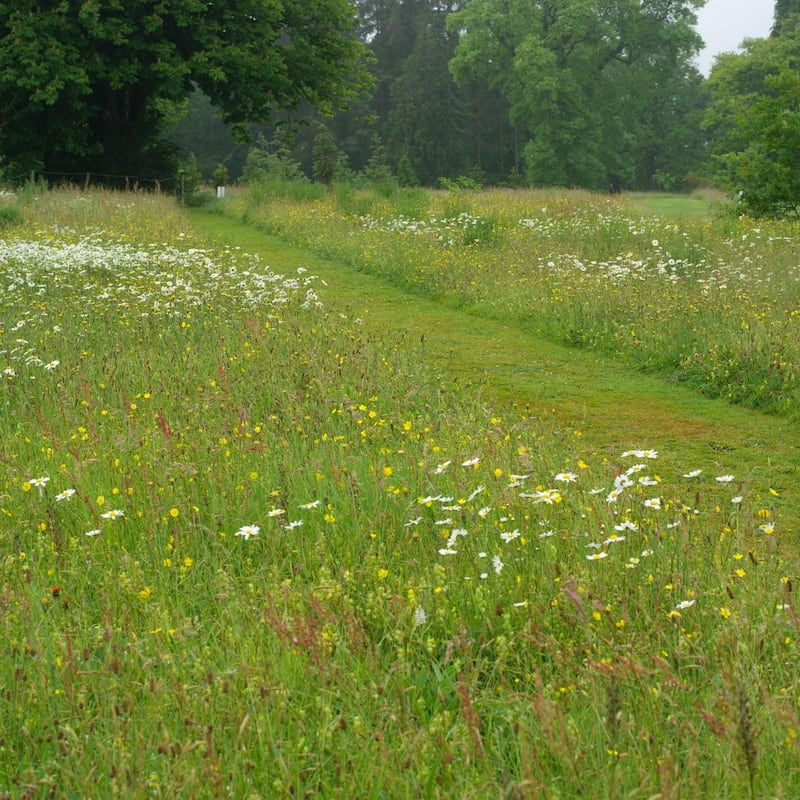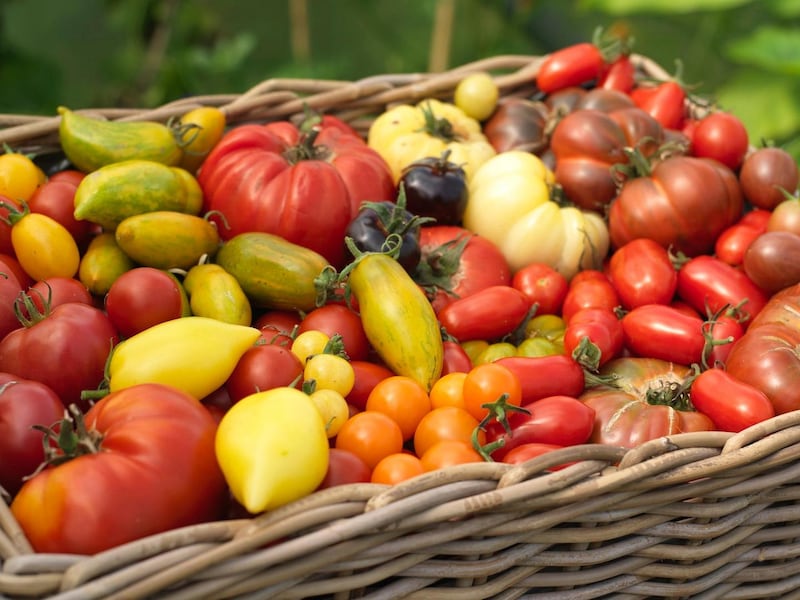Ask a group of gardeners what picture is conjured up in their mind’s eye when you say the word “meadow” and their answers will be surprisingly diverse. For some, it is the seductive image of a traditional native wildflower meadow in all its subtle, understated beauty; a place filled with the gentle charms of wild grasses, tiny orchids, yellow rattle, pignut, lousewort, bird’s-foot trefoil, ribwort and meadow vetchling. For others, it is a modern, embellished version of the former, its beauty underscored with the addition of meadow-style, non-native flowering perennials and bulbs such as astrantia, aquilegia, snake’s head fritillaries, narcissus, and starry-blue camassias that help to extend the seasons of interest.
Some gardeners prefer something with much more obvious drama and high-octane colour in terms of its vibrancy and decorative impact. In this case, the meadow's significance as an expression of native beauty is not that important. Instead it's more about creating and nurturing a self-sustaining community of decorative plants that will thrive in the growing conditions provided. These are what are often known as pictorial meadows, a term first used to describe the work of well-known UK ecologists and meadow designers James Hitchmough and Nigel Dunnett. Some of these highly decorative pictorial meadows are perennial, meaning that the plants that grow in it will survive for many years, while others (the annual kinds) are far more short-lived, blooming brilliantly over the course of just one year.

Both traditional and pictorial meadows can be grown from seed sown at this time of year (the only exception being those pictorial meadow seed mixes containing half-hardy annual species, which should only be sown in mid to late spring). You don’t need a huge space; in fact I’ve seen mini-meadows growing in postage stamp-sized gardens. But whatever sort of meadow mix you decide to sow, I can’t stress enough the importance of proper soil preparation, not only in terms of creating the best conditions for germination but also in terms of minimizing problems with weeds. Some gardeners get around the weed problem by repeatedly spraying the ground prior to sowing with a weed-killer such as RoundUp, an environmentally unfriendly approach that I don’t advocate. Others kill off any existing unwanted growth before sowing by using a mulch such as plastic sheeting to cover the ground, a method which will slowly but surely starve even annoying perennial weeds of light and water. But it needs time (a minimum of three months) to be effective. It’s also important to remember that even after killing off existing weed growth, all normal garden soils contain a “bank” of dormant weed seeds that will germinate if given the right conditions. For this reason, it’s an excellent idea before sowing your meadow to create what’s called a stale-seed bed by allowing weed seeds hidden in the soil to germinate before hoeing them away, a process that’s most effective if repeated several times. It’s also possible to suppress fresh weed germination (but not kill off existing weeds) on freshly cleared and cultivated ground by covering it with a 10cm-thick layer of coarse horticultural grit, on top of which you can then sow your meadow seed.
Although costly when/if used on large areas, this weed-suppressing mulch of horticultural grit offers another advantage when it comes to sowing meadow seed, which is that it can help to create a low-fertility growing medium. This is preferable for many meadow-style plants that in soils of normal or high fertility would be quickly smothered by more coarse, thuggish species. It’s just one method of artificially reducing soil fertility to help with good meadow establishment. Another – a costly, laborious, time-consuming one – is to remove the upper, most fertile layer of top soil (typically 15-20cm) off-site before sowing on to the less fertile sub-soil.

Pictorial meadows aside, if your aim is to turn an area of coarse grass or unloved, labour-intensice lawn into a traditional wildflower meadow, then yet another way (very effective and much less laborious) is to sow seed of yellow rattle (Rhinanthus minor), a native wildflower that’s key to the establishment of many successful traditional meadow projects. This small, hardy, hemi-parasitic annual is often found growing in old meadows and grassy stretches and has a very special trick up its sleeve, which is its ability to steal nutrients away from the competing root systems of vigorous wild grasses such as Yorkshire Fog, a coarse perennial that will often dominate a meadow at the expense of more delicate species. After it dies back every autumn, yellow rattle leaves behind bare patches of soil which provide these daintier, less vigorous meadow species with the space and opportunity they need to get established. Once established, yellow rattle also continues to set ripe seed every autumn, which germinates in spring once exposed to a period of cold weather (a strategy common to many meadow species). Over time, this inconspicuous little wildflower can have a transformative effect on a wildflower meadow’s plant diversity, as proven by head gardener Seamus O’ Brien’s skillful management of the beautiful wildflower meadows of Kilmacurragh Gardens in County Wicklow. Another example is the species-rich meadows of the famous gardens of Great Dixter in the UK.
Again, now is an excellent time to sow it. For the best chance of establishing communities of yellow rattle in existing lawns, meadows or areas of coarse grass, cut the existing vegetation to the ground and remove it before using a garden spade (or the tip of your boot) to expose little shallow pockets of bare soil, then scatter the yellow rattle seed directly onto it. From an ecological point of view, your yellow rattle seed should ideally have been sourced fresh and as locally as possible. But this isn't always a realistic option, in which case it's possible to buy it from online Irish suppliers such as wildflowers.ie and seedaholic.com. Wildflowers.ie also supplies a range of traditional wildflower meadow seed mixes whilst pictorial meadow mixes can be sourced from pictorialmeadows.co.uk. For more detailed advice on establishing a traditional wildflower meadow, get your hands on a copy of Meadows at Great Dixter and Beyond by Christopher Lloyd and Fergus Garrett (revised and updated issue published by Pimpernel Press).
This Week in the Garden

Keep an eye out for self-sown seedlings of garden plants, which can often be found in the border, in paths or even in paving cracks at this time of year. These can be gently lifted using a garden trowel or daisy grubber and then either transplanted into another position in the garden or allotment, or potted on to give as gifts or plant out later in the year/next spring. Always lift self-sown seedlings in the cool of the evening to avoid heat stress. Use a garden trowel to minimise damage to their fragile root systems and gently water them immediately after transplanting or potting on to help their roots to re-establish as quickly as possible.
This year's Totally Terrific Tomato Festival in the National Botanic Gardens in Glasnevin established a new world record for the largest number of varieties of tomato (256) to be exhibited together under the one roof , proving that Ireland is truly a nation of tomatophiles. If you're thinking about submitting an entry for next year's event, remember that September is an excellent time to home-save seed of tomatoes. As long as it's a variety that's open-pollinated and not a modern hybrid (F1 after the varietal name means that it's the latter), it will come true to type. To save the seed, gently squeeze the squishy inner pulp of the ripe fruit into a bowl, add a splash of water and then leave it somewhere warm indoors for a few days to ferment. This helps to remove the seed's slippy, gelatinous coating. Then top up with fresh water and stir before carefully discarding the water along with any floating seeds. What's left are the viable seeds, which will have sunk to the bottom. Rinse these carefully before spreading them out on on a piece of kitchen paper (you can write the name of the variety on the same tissue paper) in a warm, well-ventilated room out of direct sunlight to dry. The seeds will stick to the tissue paper but don't worry; it's actually a great way to stop them from getting lost and won't impede their germination next spring. Store somewhere cool and dry.
Try not to leave vegetable beds empty over the coming months, as it means that the soil is vulnerable and exposed to compaction and loss of nutrients while it will also become colonised with fresh weed growth. One option is to sow a crop of green manure, which will suppress weed germination and also help to replace lost nutrients and revitalise beneficial soil micro-organisms . Suitable varieties to sow at this time of year include field beans, clover, phacelia, buckwheat and winter vetch/ tares, seed of which is available to order from Sligo-based online supplier Quickcrop, (quickcrop.ie). Another solution is to mulch the ground with manure, fresh seaweed or homemade garden compost and then cover it with a layer of strong black plastic sheeting with the edges trenched into the soil to prevent it being lifted by a winter gale. Peel it away next spring and it will have rotted down, leaving behind a beautifully weed-free, fertile, crumbly tilth.
Dates for Your Diary
Tuesday 25th September (8pm), Foxrock Parish Pastoral Centre,18 Kill Lane, Dublin 18, 'Small Bulbs for a Small Garden' a talk by Richard Hobbs of UK's Witton Seeds on behalf of the Foxrock & District Garden Club, see foxrockgardenclub.com for details
Saturday 29th September (2pm), Woodville Walled Garden, Kilchreest, County Galway, 'Harvest Festival', an illustrated talk by organic gardener and author Klaus Laitenberger on his recent travels to South America and the vegetable crops suitable for cultivation in Irish gardens that he found growing there, admission is €12 including refreshments, booking essential, contact Margarita (087-9069191 or Marie (087-2711970).











